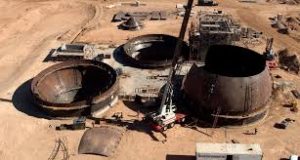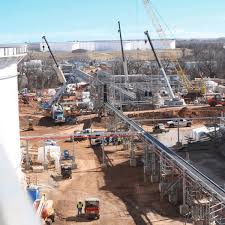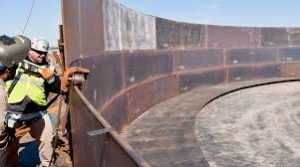
From Cushing in northern Oklahoma to the Permian Basin in Texas and New Mexico, the talk is growing of how to quickly expand crude oil storage capacity, whether it’s more massive tanks at Cushing to underground caverns in the Permian.
The North American energy sector is weighing options from building new tanks farms to more extreme alternatives such as temporarily storing crude in rail cars as US commercial crude storage threatens to fill to capacity as soon as May according to S&P Global Platts.
Oil producers, midstream firms, traders and others are considering all types of storage possibilities to capture contango profits with NYMEX WTI at about $16/b on Thursday after falling into negative territory for the first time ever on Monday. But energy analysts warn the negative-pricing potential threatens to return in the days and weeks ahead as the Cushing storage hub quickly fills to capacity, followed by other regions throughout North America.
Some of the options include converting tanks and storage wells into crude storage, utilizing all offshore floating storage, and more. The larger midstream players are deciding whether to build new storage that may not hold long-term value, while other export and refining hubs, such as Corpus Christi, Texas, are better positioned at least in the near term because they already had a wave of storage construction underway.

With working US commercial storage more than 60% full and the prominent Cushing hub rising above 76%, energy traders and analysts said all practical options must be on the table. “They’re all desperately seeking storage,” said Sandy Fielden, director of oil research at Morningstar. If storage gets too tight, NYMEX WTI and more regional hubs will again see negative crude pricing as markets have seen at times with natural gas in the Permian Basin, he warned.
Contango pricing remains in effect for some time, but NYMEX WTI doesn’t even hit $30/b until futures contracts in early 2021.
“If there’s an opportunity to make money, people are going to do it,” said Ernie Barsamian, CEO of midstream logistical firm The Tank Tiger. “Most of the big-chunk stuff got taken up by the big boys, but there’s still lots of smaller stuff. And the contango continues to roll from front month to front month [through 2021 and beyond].”
The Tank Tiger lists smaller and modest-sized storage opportunities, including caverns in the Permian, rail cars in the Bakken, floating barges off of New Orleans, and more traditional tank storage from Cushing to Brownsville, Texas. There also are options to sign on for tank storage that’s currently out of service or eventually rolling off of contracts.
“If someone has a tank that’s out of service that won’t be available for three months, then by the time it’s in service it’s likely you’re still going to see that front-month contango preserved,” Barsamian said. “But it’s a risk.”
After going through the permitting process, it only takes about three months to build new tanks in Cushing, he said, noting that a lot of conversations are ongoing as firms prepare to move quickly.
Most of the midstream companies are holding their cards tight as they consider their options and are declining comment for now. But they are expected to reveal more as midstream earnings season picks up next week, analysts said.
“We are actively evaluating opportunities to add or convert existing storage to crude oil service to meet the needs of our customers,” said Magellan Midstream spokesman Bruce Heine.
In the Bakken Shale, North Dakota energy regulators are considering offers for companies to quickly build two new crude storage tank farms of up to 500,000 barrels each in as quickly as six weeks, utilizing spare land already owned by the firms, including at an oilfield waste-treatment facility.

Texas, New Mexico and Oklahoma are all initiating varying versions of emergency rules so oil lessees could temporarily shut in wells without penalties.
Texas energy regulators also are debating whether to mandate production-cut quotas to help stabilize prices and keep storage from overflowing. However, this week they declined to implement any required cutbacks, pushing back any vote until May.
American Petroleum Institute Senior Vice President Frank Macchiarola said the industry supports efforts, such as in North Dakota, to facilitate the construction of tank storage construction, but opposes any efforts in Texas or otherwise to intervene with production quotas.
During the Texas hearing last week, Plains All American Pipeline President Harry Pefanis warned that commercial crude storage could hit capacity by mid-May and that up to 4 million b/d of US oil production could be forced offline through shut-ins. Plains is asking producers to voluntary cut back production and requiring customers to show proof of market at destination.
“There’s a wall coming and you have to be proactive.”
Enterprise Products Partners co-CEO Jim Teague countered that storage will never completely fill because buyers will always step up to scoop up extra cheap oil. “Someone will make an offer for their crude, and then they have a hard decision to make,” he said.
Diamondback Energy CFO Kaes Van’t Hof agreed. “Those barrels need to move to Asia. I’m not going to like the price, but at least those barrels will move.”
If anything, Enterprise is having a harder time with products storage, especially gasoline and diesel, than crude oil. Enterprise already has converted some natural gas liquids wells to refined fuel products. Teague said offers have been made to covert some to crude, but none have been taken thus far.
ConocoPhillips has made the biggest voluntary production cutbacks thus far, saying they’ll take 225,000 barrels of oil equivalent a day offline, including about 125,000 boe/d from its US shale plays. CEO Ryan Lance said he’d rather do it voluntarily than be forced to do so by storage shortages.
“There’s probably more involuntary actions coming as inventories build,” Lance said.
Some storage hubs such as the Houston Ship Channel and the Port of Corpus Christi already had new tank storage under construction before the coronavirus pandemic as they prepared for an ongoing surge in crude oil exports.
Now that exports are beginning to fall with the demand collapse, those storage tanks are now more desired for their longer-term storage capabilities.
“We’re in a little bit of an enviable position,” said Port of Corpus Christi CEO Sean Strawbridge.
Pin Oak Terminals just brought on about 2.5 million barrels of crude storage, he said, and close to 12 million more barrels are anticipated relatively soon. Buckeye Partners’ new South Texas Gateway Terminal project will buy another 5 million barrels of crude storage this summer. And Moda Midstream will soon add more storage, he said, after bringing some additional new storage online at the end of 2019.
As the nation’s new crude export leader, Corpus Christi has rapidly doubled from 20 million barrels of storage five years ago to more than 40 million barrels
And yet, “by my calculation, we’ll be out of storage within 60 days,” he said. Crude exports actually rose in the first quarter, but vessel traffic is quickly down about 20% in April with more declines anticipated, he said, especially once all the previously committed cargoes roll off.
“Once those hedges are mature and the traders are naked, we fully expect to see a downturn,” Strawbridge said.
EVEN BY RAIL
As the demand loss cuts into crude oil shipments by rail, companies are even considering the practicality of storing crude in rails cars for longer periods of time as other storage options are depleted.
“Any rail car that can be used to capture a large, short-term arbitrage will be,” said energy analyst Ethan Bellamy of Robert W. Baird & Co. “It’s the same with VLCCs. If you can rent tankage of any kind for less than the contango, you will.”
Converting other storage to crude storage also is more practical than building new tank farms, Bellamy said, because doing so requires less money and new permitting.
The major railway companies in the US and Canada all declined to comment on rail cars being utilized for storage, but the Association of American Railroads said it isn’t opposed to offering more storage opportunities so long as the proper local, state, and federal safety regulations are followed.
The API questioned the practicality though because crude-filled rail cars aren’t supposed to sit in one place for more than 48 hours, so there are additional logistical challenges.
While most rail terminals aren’t ideal for crude storage, some areas such as Stroud, Oklahoma, make sense because of the proximity to Cushing, Sandy Fielden said.
“When it gets down to the wire there’s a lot of possible storage that’s technically available, but not really practical,” Fielden said.
And, as Ethan Bellamy added, the more creative ideas are often far too dangerous.
“You hear a lot of joking about filling Texas swimming pools, but crude oil is a flammable hazardous material,” Bellamy said. “Casual traders with ideas toward storing crude oil in their backyard should avoid doing stupid and illegal things that could get themselves hurt, killed, or fined into oblivion.”
Pandemic oil demand destruction has converted clean products tankers into offshore storage containers as onshore storage is approaching tank top. Forced floating storage as a result of discharge problems has the products tanker markets buzzing arguably at a faster pace at present than their larger sisters on the crude side.
Source: S&P Global Platts




